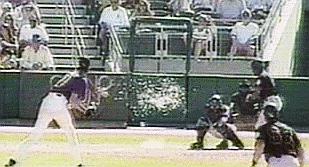 The summary of Randy Johnson's game looked like this: struck out eight and
killed one.
The summary of Randy Johnson's game looked like this: struck out eight and
killed one.
 The summary of Randy Johnson's game looked like this: struck out eight and
killed one.
The summary of Randy Johnson's game looked like this: struck out eight and
killed one.
The hard-throwing Arizona Diamondbacks pitcher was impressive as usual in his final spring-training outing last Saturday, but he drew more attention than usual because one of his fastballs managed to intersect dramatically with the flight path of a dove.
A 95-mile-an-hour pitch he threw in the seventh inning hit the bird as it flew in front of batter Calvin Murray during a exhibition game in Tucson, Ariz., against the San Francisco Giants. [See mpeg file.]
"The bird just exploded. Feathers everywhere. Poof," said Murray, who reckoned the mishap was a one-in-a-trillion shot.
Well, no. Actually, it's a whole lot less and it's likely that it will happen again before you cash in on a Lotto 6/49 ticket.
Johnson's feat can be quantified relatively easily thanks to the branch of mathematics called probability theory, which analyzes what appear to be random phenomena.
Randomness is in the eye of the beholder. Some practitioners of probability theory -- such as Jeffrey Rosenthal, a Harvard-trained University of Toronto professor -- believe that what appears to be randomness is simply our own uncertainty and that "if we knew all the facts, we could probably predict things with certainty."
Seventeenth-century French mathematicians Blaise Pascal and Pierre de Fermat began the practice of analyzing the random in response to the request of prominent gamblers. These early theorists examined games based on cards, dice and roulette wheels.
The coin toss was the simplest. There are only two probabilities -- heads and tails -- and with an evenly weighted coin they are equally likely outcomes and thus are assigned the same probability, 1 in 2.
The same analysis applies to dice, where there is a 1-in-6 probability on each roll that a five, say, will appear. With cards, there is a 1-in-52 chance that the king of hearts will be drawn from a full deck.
They came up with the Law of Large Numbers, which says simply that the proportion of performances in which some specified outcome occurs is roughly equal to the underlying probability of that outcome. If you toss a coin 1,000 times and it comes up heads only 489 times, it simply means you haven't tossed it enough and that eventually you will get a 50-50 split.
The gamblers, however, wanted more. If Marc paid Jean-Louis a franc every time a coin flip came up heads, what is the probability that he would go through his capital? The answer, the so-called Gambler's Ruin formula, is fundamental to probability theory (and to an insurance industry that is doing little more than betting on the health and longevity of individuals).
It gets much more complicated, of course, and a decent probability formula -- with brackets, exclamation marks, numbers below and above lines and Greek letters -- can go on and on.
Rosenthal is clearly engaged by the discipline. This is natural -- both his parents are math professors at the university. It's safe to say the pads and pencils came out quickly when someone at the Rosenthal dinner table said (as numerous sports reporters did this week), "What are the chances of that happening, eh?"
Rosenthal does not buy Lotto 6/49 tickets. It takes him about a minute to go through the formula, replete with a binomial co-efficient, that shows his chances of success are about one in 14 million.
It takes only slightly longer to deal with Johnson's pitch.
Certain assumptions are made, first that there are 100 doves in the square kilometre around the Tucson ballpark. It is also assumed that they are flying in no apparent pattern with no particular attraction or repulsion related to baseball-stadium smells -- sweat, pine tar, peanuts, spilled beer, or even Murray's after-shave.
Next, Rosenthal had to guess the diameter of a dove's body and of a baseball to calculate the volume of space where a dove could be hit by a pitch. There are no birds or balls in his office, so each is assumed to be about 10 centimetres in diameter. The distance between the pitcher's rubber and home plate -- always stated as 60 feet 6 inches -- is put down as roughly 18 metres.
After that, it's simple work -- for Rosenthal, at least -- to calculate that Johnson's pitch was a 1-in-13-million thing. In other words, a dove minding its own business in Tucson last Saturday stood a better chance of not seeing nightfall than you did of winning the lottery.
It's all quite satisfying to see it there on paper, but Rosenthal notes: "The dove probably wasn't so amused by probability theory."